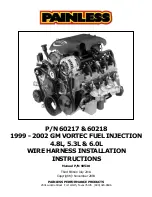
10
NEVER disassemble the fuel pump or pressure regulator.
Their original performance may not be restored after
reassembly.
DO NOT obstruct the small rectangular hole in the side of
the regulator cover.
DO NOT allow foreign matter to enter the fuel system. Dirt
inside the pump or regulator, no matter how small, may
obstruct the flow of fuel and prevent these components from
working properly.
NEVER insert anything into the inlet or outlet nipples in an
attempt to clear a suspected obstruction. (See CARE &
MAINTENANCE section at the back of this booklet.)
ALWAYS use fuel filters. Keep the fuel tank scrupulously
clean and filter all fuel as it enters the tank (e.g.via an
O.S.'Super-Filter' Code No.72403050) and use a good
quality in-line filter between the tank and pump. Remember
to inspect filter screens at regular intervals and rinse clean
as necessary.
NEVER use gasoline, kerosene, diesel fuel or other
petroleum products for cleaning the pump, regulator or fuel
lines. Silicone-rubber parts will be ruined by these materials.
Use only alcohol (methanol) or glow fuel for cleansing these
items.
The choice of propeller depends on the design and weight of
the aircraft and on the type of flying in which you will be
engaged. Determine the best size and type after practical
experimentation.
As a starting point, refer to the props listed in the
accompanying table.
Slightly larger, or even slightly smaller, props than those shown
in the table may be used, but remember that propeller noise will
increase if blade tip velocity is raised, due to higher rpm or if a
larger-diameter / lower-pitch prop is used.
PROPELLERS
Type
Size (DxP)
Stunt planes
11x11-12, 12x10-12, 13x9
13x9, 14x7, 15x6, 16x6
12x8(3-blade)
Scale models
Make sure that the propeller is well balanced. An
unbalanced propeller and / or spinner can cause serious
vibration which may weaken parts of the airframe or
affect the safety of the radio-control system.
DO NOT forget the WARNINGS and NOTES on propeller
and spinner safety given on pages 2,3 and 4.
•
•
•
•
•
•
Warning:
Type
Size (DxP)
Stunt planes
11x9-10, 12x7-8, 12.5x6
13x8, 14x7, 11x7(3-blade)
Scale models
FS-70S
Ⅱ
FS-91S
Ⅱ
/91S
Ⅱ
-P
11
FUEL
The FS-70S
Ⅱ
, FS-91S
Ⅱ
and FS-91S
Ⅱ
-P should be
operated on a methanol based fuel containing not less than
18% castor-oil, or a top quality synthetic lubricant (or a
mixture of both), plus a small percentage (5-15%) of
nitromethane for improved flexibility and power. The
carburettor is adjusted at the factory for a fuel containing 20%
lubricant and 10% nitromethane.
Some commercial fuels also contain coloring additives as an
aid to fuel level visibility. In some cases, these additives have
indicated slightly negative effects on performance. We would
suggest that you use such fuels only if you are satisfied that
they do not adversely affect running qualities when compared
with familiar standard fuels.
When changing to a fuel brand or formula that is different
from the one to which you are accustomed, it is a wise
precaution to temporarily revert to in-flight running-in
procedures, until you are sure that the engine is running
entirely satisfactorily.
GLOWPLUGS
The role of the glowplug
Glowplug life
Particularly in the case of very high performance engines,
glowplugs must be regarded as expendable items.
Imstall a plug suitable for the engine.
Use fuel containing a moderate percentage of nitromethane
unless more is essential for racing events.
Do not run the engine too lean and do not leave the battery
connected while adjusting the needle.
However, plug life can be extended and engine performance
maintained by careful use, i.e.:
With a glowplug engine, ignition is initiated by the application
of a 1.5-volt power source. When the battery is disconnected,
the heat retained within the combustion chamber remains
sufficient to keep the plug filament glowing, thereby continuing
to keep the engine running. Ignition timing is 'automatic' :
under reduced load, allowing higher rpm, the plug becomes
hotter and, appropriately, fires the fuel/air charge earlier;
conversely, at reduced rpm, the plug becomes cooler and
ignition is retarded.
Apart from when actually burned out, a plug may need to be
replaced because it no longer delivers its best performance,
such as when:
When to replace the glowplug
The FS-70S
Ⅱ
, FS-91S
Ⅱ
and FS-91S
Ⅱ
-P are supplied with
an O.S. Type F glowplug, specially designed for O.S. four-
stroke engines.
Filament surface has roughened and turned white.
Filament coil has become distorted.
Foreign matter has adhered to filament or plug body has
corroded.
Engine tends to cut out when idling.
Starting qualities deteriorate.

































